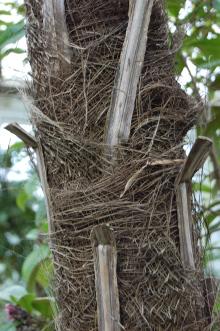
Trachycarpus martianus (09/02/2013, Kew Gardens, London)
Position: Full sun to light shade
Flowering period: Late summer
Soil: Moist, well drained
Eventual Height: 12m
Eventual Spread: 2m
Hardiness: 9a – 11
Family: Arecaceae
Trachycarpus martianus is an evergreen palm with an unbranched single stem. Its mid green leaves are a rounded, fan shape and up to 1.5m across. Its trunk is said to be smooth, however the specimen photographed here was covered in a fibrous mat. Its yellow dioecious flowers appear as large pendant panicles and appear from the leaf bases. Its fruit is the size and shape of a coffee bean.
Trachycarpus martianus, commonly known as Martius’ Fan Palm or Khasia Hills Fan Palm, is native to north India and central Nepal

Trachycarpus martianus Leaf (09/02/2013, Kew Gardens, London)
The etymological root of the binomial name Trachycarpus is derived from the Greek trachus meaning rough, and karpus meaning ‘a fruit’, due to the fruit of some species being hairy. Martianus is named after Karl Freiedrich Phillip Martius (1794 – 1868).
The landscape architect may find Trachycarpus martianus useful as an attractive palm, either planted as a specimen, in rows or avenues. Once established this palm is drought tolerant.

Trachycarpus martianus Bark (09/02/2013, Kew Gardens, London)
Ecologically, Trachycarpus martianus is attractive to pollinating insects.
Trachycarpus martianus prefers moist, fertile, well-drained soils. It tolerates most pH of soil.
Trachycarpus martianus requires little maintenance.

